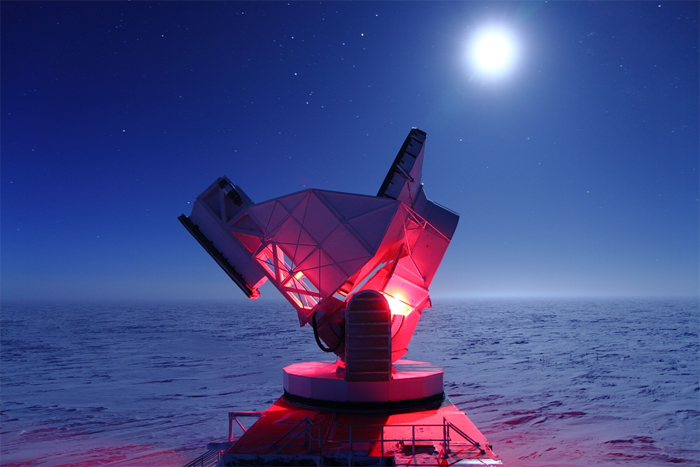Q&A with Michael McDonald
For more background about the Phoenix Cluster, including how it was discovered and the meaning of its adopted name, we have interviewed the first author Michael McDonald. Michael has recently started a Hubble postdoctoral Fellowship at the Kavli Institute for Astrophysics and Space Research at the Massachusetts Institute of Technology. He received Bachelor degrees and a Masters of Science from Queen’s University in Canada, and a PhD from the University of Maryland. His scientific interests include the observation and study of clusters of galaxies, individual galaxies, and the intracluster plasma that fills the space between galaxies.
Q: Please explain the astronomical justification for calling this the Phoenix Cluster and discuss why the name is meaningful for someone who isn't an astronomer.
A: Traditionally, astronomical objects such as stars, galaxies, and clusters of galaxies were named based on their location in the sky with respect to the constellations. For example, we have the Virgo cluster, the Andromeda galaxy, and Alpha Centauri the stellar system.
As we discover more and more celestial objects, these names become cumbersome, and astronomers, like librarians, use names that allow indexing of the objects. For example, the proper name of this cluster is SPT-CLJ2344-4243, which tells us that it was discovered by the South Pole Telescope (SPT) at a position on the sky with a right ascension of 23:44 and a declination of -42:43.
However, due to the extreme nature of this system, we thought it deserved a more classical name. As luck would have it, the cluster is located in the constellation "Phoenix", which was inaccessible to early astronomers due to its proximity to the South Pole, and thus the name "Phoenix Cluster" was still up for grabs.
As it turns out, this name is meaningful beyond the cluster's location in the Phoenix constellation. In the centers of galaxy clusters, astronomers think that the formation of new stars ceased roughly 10 billion years ago, as evidenced by the fact that most nearby clusters contain only old stars in their centers. However, the Phoenix cluster appears to be forming stars at an exceptionally high rate, suggesting that it has somehow come back to life, so to speak.
Q: How was the Phoenix Cluster originally discovered?
A: The Phoenix Cluster was originally discovered by the South Pole Telescope (SPT), a microwave and millimeter-wave telescope, in 2010 as part of the initial 2500 square degree survey, and the detection was published in a paper presenting the most massive SPT-detected clusters by R. Williamson in 2011.
Q: Did you have strong suspicions straight away that this was an exceptional object, based on just the SPT data, or did it take longer such as waiting for the Chandra data?
A: In Williamson's 2011 paper, he stated that "this cluster is measured to have the largest X-ray luminosity of any cluster in this paper," based on archival X-ray data from the now-defunct ROSAT space telescope. At the time, this wasn't terribly significant, as the paper only included 26 clusters and the X-ray luminosity was highly uncertain. The cluster was essentially forgotten about at that point, until in summer of 2011 when we observed the cluster with Chandra as part of a large, X-ray Visionary Project to observe the 80 most massive SPT-selected clusters. It was immediately apparent from the Chandra image that this cluster was exceptionally luminous and amongst the most massive clusters in the Universe.
Q: Was there a "Eureka moment" when you obtained the first few star formation estimates, or were you and your collaborators more cautious, based on just a small number of measurements?
A: By nature I'm an extreme optimist, so the moment I saw the first optical spectrum I thought that this could be a unique cluster. We just so happened to have observing time at Magellan the same month, so we made observing this cluster a priority. The spectra from this fortuitously-timed run are those presented in the Nature article. The combination of the optical spectra, and the archival UV data (another happy coincidence!) was enough to convince me that this was an extreme starburst. Of course, to convince the more pessimistic scientist, we performed a careful analysis in the article, ruling out several alternative hypotheses.
Q: Do you have any interesting stories about the discovery process, including your efforts to collect so much multi-wavelength data?
A: It was a very exciting few weeks following the arrival of the first Chandra data. It seemed like every time I looked at the cluster at a different wavelength (e.g. UV, optical, infrared, radio, gamma rays) there was something even more interesting.
First it was the most X-ray luminous cluster known in the Universe. Then the spectra revealed that it was also the strongest cooling cluster known. Then the early optical spectroscopy showed that it was star-forming, and the follow-up showed that the star formation was extended and filamentary (reminiscent of what is seen in Perseus). Further, the optical spectra showed that the system was extremely dusty, suggesting that we had under-estimated the UV-derived star formation rate by a factor of 10! This prompted follow-up infrared observations with Herschel, which revealed the central galaxy belonged to a rare class of object known as ultra-luminous infrared galaxies (ULIRGs).
Finally, as if the system wasn't already interesting enough, we discovered that there was a gamma-ray source coincident with the central galaxy, indicating an extremely active supermassive black hole. These discoveries happened over the span of 1-2 weeks, during which time I was frequently showing up at colleagues' doors saying "There's more!"
Q: There are 85 co-authors on your paper. How did the collaboration decide that you would write up the results for publication?
A: It never seemed like it was a collaboration-wide decision, it just happened organically. My research has been focused on cooling flows and star formation in galaxy cluster cores, so I think it was fortuitous that I was the one looking at the X-ray data, as I recognized "the signs" right away. Once we realized how exciting this system was, I was in so deep that it just made sense for me to lead the project.
Q: Your team is observing more galaxy clusters. Are you hopeful about finding more objects like the Phoenix Cluster?
A: Of course! I wouldn't be surprised if this was the most extreme system, as it's hard to imagine something forming stars or cooling at a higher rate and remaining undiscovered for this long. However, I expect that we'll find similar systems -- central galaxies with starbursts fueled by the cooling intracluster medium -- as the survey nears completion later this year.
- Peter Edmonds, CXC
Category:
- Log in to post comments



